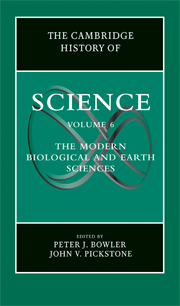Book contents
- Frontmatter
- 1 Introduction
- PART I WORKERS AND PLACES
- PART II ANALYSIS AND EXPERIMENTATION
- PART III NEW OBJECTS AND IDEAS
- 20 Plate Tectonics
- 21 Geophysics and Geochemistry
- 22 Mathematical Models
- 23 Genes
- 24 Ecosystems
- 25 Immunology
- 26 Cancer
- 27 The Brain and the Behavioral Sciences
- 28 History of Biotechnology
- PART IV SCIENCE AND CULTURE
- Index
- References
21 - Geophysics and Geochemistry
from PART III - NEW OBJECTS AND IDEAS
Published online by Cambridge University Press: 28 November 2009
- Frontmatter
- 1 Introduction
- PART I WORKERS AND PLACES
- PART II ANALYSIS AND EXPERIMENTATION
- PART III NEW OBJECTS AND IDEAS
- 20 Plate Tectonics
- 21 Geophysics and Geochemistry
- 22 Mathematical Models
- 23 Genes
- 24 Ecosystems
- 25 Immunology
- 26 Cancer
- 27 The Brain and the Behavioral Sciences
- 28 History of Biotechnology
- PART IV SCIENCE AND CULTURE
- Index
- References
Summary
Geophysics is the branch of experimental physics concerned with the earth, atmosphere, and hydrosphere. It includes such fields as meteorology and oceanography, but attention is restricted here to geodesy, gravimetry, seismology, and geomagnetism. Geochemistry is the study of the distribution and migration of the different elements in the earth, oceans, and atmosphere and therefore involves the chemical analyses of minerals, rocks, and the atmosphere, and mineral solutions. Modern geochemical research makes much use of studies of the radioisotopes of the different elements, which are also used for radiometric dating. In such work, the boundaries between geophysics, geochemistry, and geology are indistinct.
Geophysics is an important field, both practically, as in earthquake studies, and theoretically, as exemplified by geophysicists’ contributions to the establishment of plate tectonics (see Frankel, Chapter 20, this volume). Geochemistry is likewise important: practically, as in geochemical prospecting, and theoretically, especially regarding the earth’s origin and cyclic processes, some involving living organisms. Neither field has attracted the historical attention it deserves, although there are a number of useful sources that offer information and insights of relevance. Beacuse these areas are less well known than other aspects of the earth sciences, this chapter will include outlines of the major scientific developments before indicating what is known about their history.
- Type
- Chapter
- Information
- The Cambridge History of Science , pp. 395 - 415Publisher: Cambridge University PressPrint publication year: 2009
References
- 2
- Cited by



